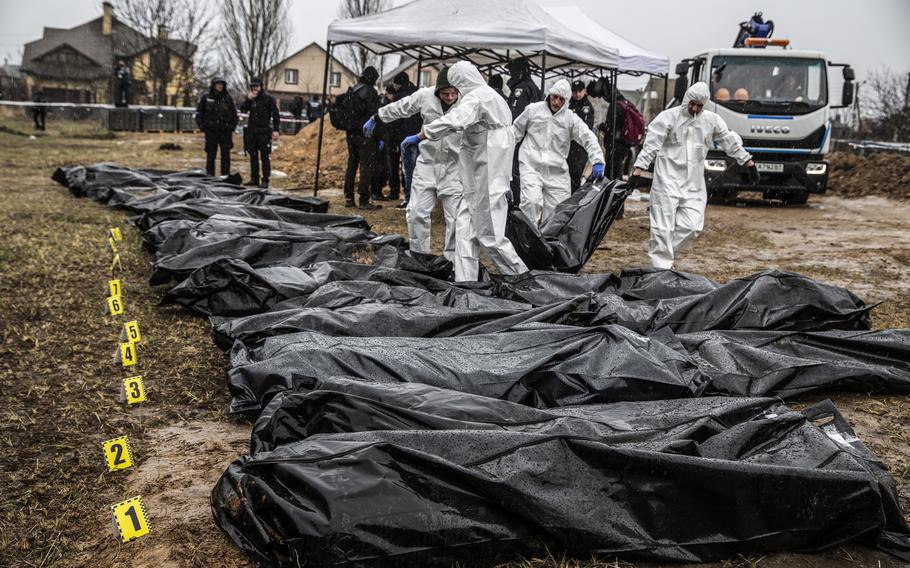
Bodies exhumed from a mass grave in Bucha, Ukraine, on April 8, 2022. (Heidi Levine/The Washington Post)
BUCHA, Ukraine — After months of meticulous, painful and at times gruesome investigation, officials in Bucha said Monday that they had reached what may be the closest they will get to a final accounting of victims of alleged atrocities by Russian troops that set off worldwide outrage: 458 bodies, of which 419 bore markings they had been shot, tortured or bludgeoned to death.
Mykhailyna Skoryk-Shkarivska, the town’s deputy mayor, recounted that grim tally at a news conference Monday, where she said the details of each case were now being investigated by prosecutors working to identify the perpetrators and ultimately try them for war crimes.
Of the victims, 39 appeared to have died of natural causes, Skoryk-Shkarivska said, but those may have been related to the war or to the Russians’ treatment of the civilian population during their month-long occupation, which ended with a hasty retreat on April 1.
Even those 39 cases are now being scrutinized by war crimes investigators. They include a seemingly healthy 34-year old mother who died of a heart attack while sheltering from bombardments in a basement with her three young children, who remained trapped alongside their dead mother for days, and an elderly woman living alone with her sister who died shortly after her sister was shot by Russian troops - deaths that hardly could be considered natural.
That it has taken more than four months to account for 32 days’ worth of killing underscores the horrific circumstances officials encountered when the Russians troops left. Bodies were strewn unattended around the streets, stuffed into wells or abandoned deep in the forest. Electricity and internet service had been cut, meaning the earliest documented evidence had to be written by hand, Skoryk-Shkarivska said.
Identifying all of the bodies proved impossible. Some 50 corpses remain unidentified or unclaimed by relatives, Skoryk-Shkarivska said, adding that city officials nonetheless decided to announce their findings because the final tally, and complete identities, probably will never be known. Just in the past two weeks, two more bodies were discovered, in a forest and a storm drain, and 10 residents have reported missing relatives who cannot be accounted for.
The final figure also includes one bag of body parts. The remains were too fragmented, decomposed or badly mutilated to be identified but apparently belonged to multiple people, Skoryk-Shkarivska said, perhaps including some Russian soldiers. Among the pieces are two right arms that investigators say they have reason to suspect belonged to Russians.
The Russian troops left the corpses of many of those they killed to rot unattended but also burned some, possibly out of hygiene concerns or to hide evidence of torture, the deputy mayor said. Some of the remains consisted of piles of ashes beyond identification even using DNA analysis.
Nearly all of the bodies included in Monday’s tally are known to have been civilians, Skoryk-Shkarivska said. The bodies of Ukrainian soldiers killed in Bucha were turned over to Ukrainian authorities and counted separately, while three Russian bodies were sent for repatriation.
A total of 366 of the bodies were male, and 86 were female, while five had deteriorated too badly to determine. Nine were children under age 18.
The stark numbers offer only a hint of the horrors inflicted on the small number of people who remained behind after the Russians swept into the Kyiv suburb on Feb. 27, intent on reaching the capital 20 miles away. Instead, they found their advance blunted by Ukrainian resistance.
Most of the town’s estimated 39,000 population escaped before the Russians arrived, but some 4,000 remained — 1 in 10 of whom died in just over a month.
If such numbers are being repeated in only a fraction of the towns and villages under Russian occupation — amounting to 20% of Ukrainian territory — the full scale of atrocities committed by Russian troops could be vast.
Bucha, however, experienced by far some of the worst of the violence among the dozens of towns and settlements briefly occupied by Russian troops in the Kyiv region, accounting for a third of the estimated total of 1,300 victims.
Many of those who stayed in Bucha when the Russians invaded were elderly, refusing to flee, because they were too frail, sick or stubborn to leave their homes, said Andriy Halavin, the priest of the town’s church.
He helped bury 116 people killed in the first two weeks of the Russian occupation in a mass grave dug by residents in the yard of his church, and he recognized some of his congregants. But others may have relatives who live far away and were unable to provide DNA samples to help investigators.
Records compiled by the investigators indicate that many of those unidentified were also elderly, said Eugene Spirin, one of the volunteers who helped collect and identify the dead. He shared a list documenting some of those that proved hardest to identify, accompanied by brief descriptions of what investigators were able to establish about who they were.
There is the man, about 60 years old, shot in the eye, his face barely recognizable, and another age 75 to 85 with stubby gray hair who was shot in the back of the head. One elderly woman’s head was so badly smashed it could not be recognized. Investigators assessed that she was 75 to 85, according to the records.
Skoryk-Shkarivska said the effort to identify these victims will continue. The city is determined to put names to all those who died and memorialize them with a monument. But if final answers don’t come soon, the city said, it plans to hold burial services for the last remaining victims who died lonely, nameless deaths.